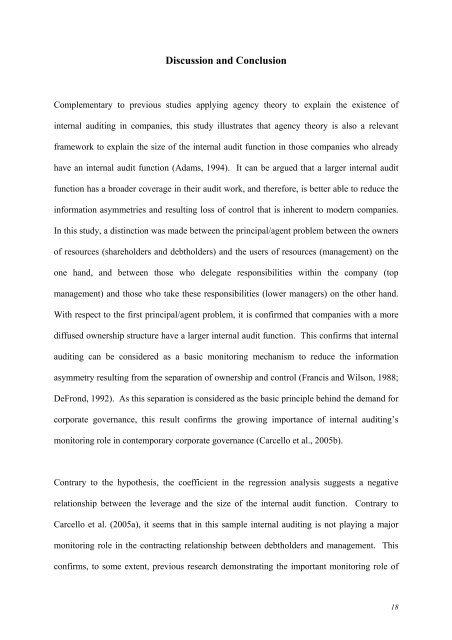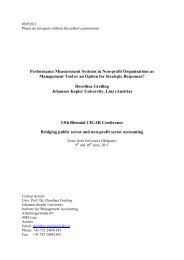WORKING PAPER - Faculteit Economie en Bedrijfskunde
WORKING PAPER - Faculteit Economie en Bedrijfskunde
WORKING PAPER - Faculteit Economie en Bedrijfskunde
You also want an ePaper? Increase the reach of your titles
YUMPU automatically turns print PDFs into web optimized ePapers that Google loves.
Discussion and Conclusion<br />
Complem<strong>en</strong>tary to previous studies applying ag<strong>en</strong>cy theory to explain the exist<strong>en</strong>ce of<br />
internal auditing in companies, this study illustrates that ag<strong>en</strong>cy theory is also a relevant<br />
framework to explain the size of the internal audit function in those companies who already<br />
have an internal audit function (Adams, 1994). It can be argued that a larger internal audit<br />
function has a broader coverage in their audit work, and therefore, is better able to reduce the<br />
information asymmetries and resulting loss of control that is inher<strong>en</strong>t to modern companies.<br />
In this study, a distinction was made betwe<strong>en</strong> the principal/ag<strong>en</strong>t problem betwe<strong>en</strong> the owners<br />
of resources (shareholders and debtholders) and the users of resources (managem<strong>en</strong>t) on the<br />
one hand, and betwe<strong>en</strong> those who delegate responsibilities within the company (top<br />
managem<strong>en</strong>t) and those who take these responsibilities (lower managers) on the other hand.<br />
With respect to the first principal/ag<strong>en</strong>t problem, it is confirmed that companies with a more<br />
diffused ownership structure have a larger internal audit function. This confirms that internal<br />
auditing can be considered as a basic monitoring mechanism to reduce the information<br />
asymmetry resulting from the separation of ownership and control (Francis and Wilson, 1988;<br />
DeFrond, 1992). As this separation is considered as the basic principle behind the demand for<br />
corporate governance, this result confirms the growing importance of internal auditing’s<br />
monitoring role in contemporary corporate governance (Carcello et al., 2005b).<br />
Contrary to the hypothesis, the coeffici<strong>en</strong>t in the regression analysis suggests a negative<br />
relationship betwe<strong>en</strong> the leverage and the size of the internal audit function. Contrary to<br />
Carcello et al. (2005a), it seems that in this sample internal auditing is not playing a major<br />
monitoring role in the contracting relationship betwe<strong>en</strong> debtholders and managem<strong>en</strong>t. This<br />
confirms, to some ext<strong>en</strong>t, previous research demonstrating the important monitoring role of<br />
18
















